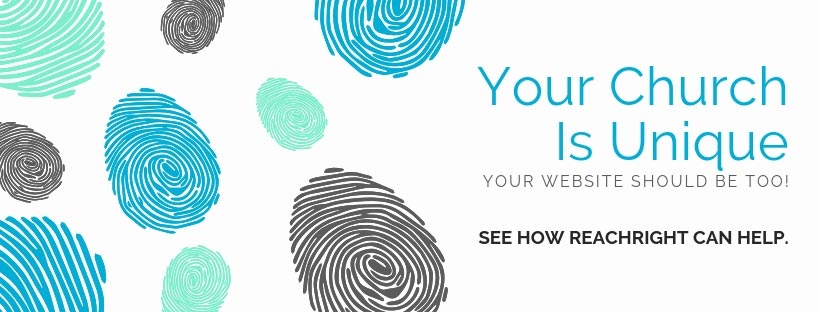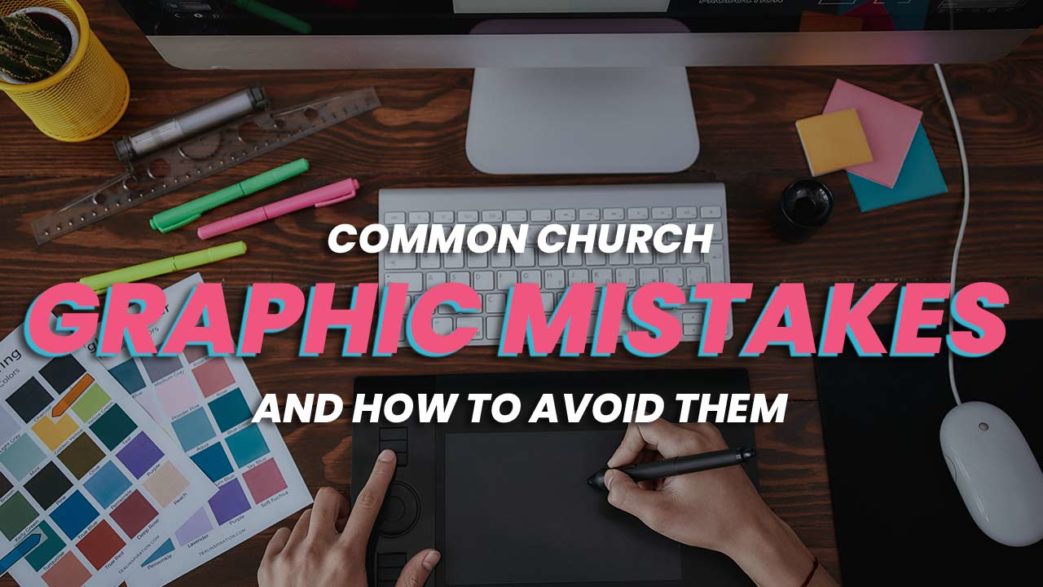Graphics make your church’s messages stand out, but common church graphics mistakes could have the opposite effect.
The good news is these mistakes are incredibly easy to avoid once you know what they are. This means you’ll see far better results from your church website, social media and even print materials.
Getting your graphics strategy just right may take a little time. Don’t be afraid to ask for feedback from members and try out different types of images to see what people respond to best.
Table of contents
- Using Low Quality Images
- Using Generic Stock Images For Everything
- Adding Too Much Text
- Playing Around With Too Many Fonts
- Using Text Colors That Blend In
- Trying To Design Everything From Scratch
- Not Taking Advantage Of Free Graphics Tools
- Not Creating Your Own Images
- Using The Same Images Repeatedly
- Not Using Color Contrast
- Not Testing Graphics On Multiple Platforms
- Not Keeping A Consistent Theme
- Using Too Many Graphics
- More on Church Graphics Mistakes

Using Low Quality Images
Low quality images is the one of the most common church graphics mistakes. These often look great wherever they’re downloaded from, but when they’re uploaded, they look blurry or grainy. This is typically due to automatic editing on your website or social media that compresses the image to optimize loading speeds.
Or, it could be that the image doesn’t look as good when you resize it to fit in the space you have available. Another issue is a printed image scanned in to use online or vice versa may not look nearly as sharp as the original.
Whatever the cause, anytime an image looks blurry, washed out or otherwise unclear, skip it. There are so many free graphics sites available with crisp, clear images that there’s no reason not to always use high-quality images for your church.
It’s also a good idea to test any images you use online on different devices and browsers. You want to make sure your graphics look just as good on desktops as mobile devices and vice versa.
Using Generic Stock Images For Everything
First of all, there’s nothing wrong with stock images. They’re incredibly useful to add to a blog post or edit a little for a social media post. However, using generic stock images for everything makes your church feel more generic as well. Career Foundry actually lists irrelevant images as a major UI design mistake that makes your brand seem less personable.
If you’re using stock images, always choose carefully. Pick images that really do fit in with your text. Whenever possible, though, use graphics that you create yourself. Your church’s homepage, for instance, should only feature images of your church, staff and members. You would also have other graphics, such as your church’s logo. This helps people relate to your church more easily. When you’re using the same images that people have seen on numerous websites and social media pages, they tend to overlook the graphic and even the text.
Adding Too Much Text
Adding text to graphics is a great idea. It’s the perfect way to draw attention to important text. However, a graphic isn’t the place for an entire blog post or other large blob of text. The problem is, the more text you add to a graphic, the harder it becomes to read.
Even when the graphic is more transparent, parts of the text will inevitably blend in. Finding the perfect graphics where this doesn’t happen is nearly impossible.
Use graphics as the background for a title, scripture, short announcement or invitation or something similar. You can also use the graphic as a link to the rest of the text or place the rest of the text under the graphic. This makes everything easier to read, but still allows your church to use the graphic to attract attention.
Playing Around With Too Many Fonts
You might not think of fonts and graphics together, but one of the more surprising church graphics mistakes is using too many fonts. Fonts are a type of graphical element. However, using too many types is more distracting than anything else.
You’ve likely seen websites where every line of text seems to be a different font. The idea is the various types of fonts will draw the eye better, but instead, things seem more cluttered and unprofessional. Think about the early days of PowerPoint presentations where each headline and bullet point was a different font, color and even animation. It was fun and cute back then, but now, things are much more professional.
Churches, and all types of businesses, may use a variety of fonts to create more textual looking graphics or to make the text stand out better on top of graphics. Instead of doing this, stick with a few font families and instead use different font sizes and emphasis (bold, italics) to make certain lines and words more impactful.
While this rule applies for both online and offline graphics, reducing the number of fonts you use online actually helps boost your site’s loading speed and performance. It’s a simple tweak that has double the benefits.
Using Text Colors That Blend In
This is one of the easier church graphics mistakes to make. People perceive colors differently. While bright red text on a dark red background might look okay to you, it could easily blend in for others.
Ideally, avoid mixing similar colors. Otherwise, your carefully crafted graphics might just disguise your important text. This is why it’s a good idea to avoid using bright or neon colors on dark backgrounds as everything blends together.
This often happens when using banner graphics to display headlines. Always ask other people to look over your graphics and text to ensure your text stands out like you need it to.
Trying To Design Everything From Scratch
Yes, unique is great. That doesn’t mean you have to buy or design everything from scratch. It’s perfectly okay to use templates whenever possible. For example, you could take a stock image that has a bulletin board or whiteboard on it. Then, simply edit the image to add different text for announcements each month in your church newsletter.
You can also use graphics editors to change color, contrast, size and shape. Combine multiple graphics into one graphic. Many of these editors also include free or premium templates to help you create unique graphics in just minutes.
Once you find easy to edit graphics that you can use over and over, keep them all together so you have templates ready for sermon slides, presentations, website pages, blog posts, social media posts, newsletters and more. It may take you a little time to gather everything together initially, but once you do, you’ll save valuable hours or searching for new graphics.

Not Taking Advantage Of Free Graphics Tools
Are you struggling to not only find graphics, but edit them? You don’t need to be a graphics designer or try to figure out complex tools. One of the easiest church graphics mistakes to make is not taking advantage of all the free graphics tools available online. Often, you don’t even need to download anything, making them ideal for creating graphics on the go.
There are a variety of free graphics platforms for editing existing graphics and creating unique graphics from templates. While you might not have the most advanced options, you’ll have everything you need for quick and easy graphics editing and creation.
Of course, there are also premium options available if you need more functionality. You’ll usually find better templates and a larger library of graphics included. Whether you’re using free or premium graphics tools, make sure you keep a list of free and premium graphics and images sources on hand to quickly find what you need.
Not Creating Your Own Images
With an endless variety of graphics and images online to download, you might not think about creating your images. You don’t have to create something completely new all the time, though. However, it’s a good idea to add something that’s 100% just for your church.
The easiest method is to take pictures in and around your church. Use them to create collages, add to blog posts, show your church’s personality on social media and anywhere else you use graphics. If you do have any graphics skills, you can use free drawing tools to design simple or highly complex graphics. Don’t be afraid to ask your members, including online followers, if anyone would be willing to help out with this.
Another option is to ask members and online followers to send in drawings, digital creations and so on. Not only can you showcase your church family’s incredible artistic abilities, but you’ll have truly unique graphics to use. Just make sure members are okay with you using their images.
Using The Same Images Repeatedly
How often have you seen a blog or social media page where the same image is used over and over? Yes, it’s easy, but once you see the same image multiple times, how much attention do you pay to the text included? For most people, they see the same image and assume it’s the same text.
It’s okay to use the same image for certain things, but try to edit it. For instance, the bulletin board example earlier. If you always use that graphic for a church announcement, people know to check the text each time. But, if you use the same graphic to promote every single blog post on Facebook, none of your posts will stand out.
At the very least, rotate through a large collection of graphics. Spice things up to make your church stand out.
Not Using Color Contrast
Using the right color contrast helps graphical elements stand out. The same is true for any text you may use on top of graphics. UX Planet talks about the importance of using contrasting colors to draw attention naturally without making anything difficult to see or use. While it’s focused more on app design, the same principles hold true for all types of digital graphics and print graphics.
One thing to take away from the UX Planet post is the different ways colors go together, such as complementary vs. analogous. Each type of contrast has its own pros and cons.
Using the right color contrast is just as important as picking the right color scheme for your church. The good news is you can use the same color scheme or a similar one for your graphics to create a more cohesive church brand.
Not Testing Graphics On Multiple Platforms
One of the easiest church graphics mistakes to make is not testing out the look on multiple platforms. If it looks great on your desktop on XYZ browser, it must look the same everywhere, right? While we’ve already touched lightly on this point, it’s worth mentioning again. Graphics will look slightly different on various browsers, devices and even print mediums.
Always test your graphics on as many different platforms as possible. For example, if you want to see how graphics look on mobile devices, check Android (check multiple manufacturers) and iOS devices. Test out your graphics in several major browsers, such as Chrome, Firefox, Safari, etc.
If you’re using print graphics that’ll be on different materials, do a test run of each material to ensure the graphics turn out correctly. For example, the color you choose for paper might not be quite bright or dark enough for a t-shirt.
Not Keeping A Consistent Theme
In a desire to make graphics unique and to stand out more, it’s easy to stray from your church’s overall theme. Yes, things stand out, but everything stands out, making everything seem incredibly cluttered.
For example, check out Ling’s Cars. There’s so much going on that it’s difficult to focus on any one part of the site. Plus, there are so many different colors and fonts, there’s not any real theme outside of chaotic.
Try keeping a consistent theme with similar colors and types of images. Use the same font families.
Think of it like this. Would you use a different church logo for your website, social media, newsletter, print marketing and so on? No. You’d use the same logo. This creates consistent branding, which helps people instantly recognize that the message is from your church.
Using Too Many Graphics
Finally, there is such as a thing as too many graphics. Imagine if your church website looked more like a massive Pinterest board than an actual website. It’d be hard for people to find what they’re looking for. Much like text, graphics need to be spaced out. Only use them where appropriate. Every block of text doesn’t need its own graphic.
White space is a good thing. It makes every other element stand out more. This applies for both online and offline graphics. This is one of the easier church graphics mistakes to notice. Odds are, a member or visitor will point it out for you.
More on Church Graphics Mistakes
Want to start implementing a new graphics strategy? Start with a professional designed website that helps your church grow. See how our church web design services can help.




